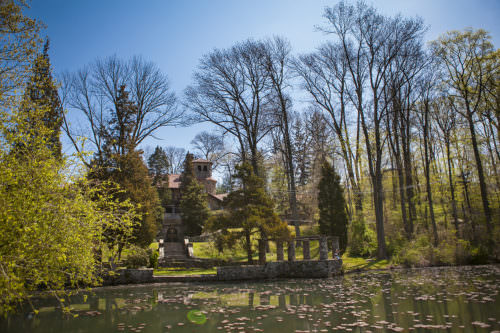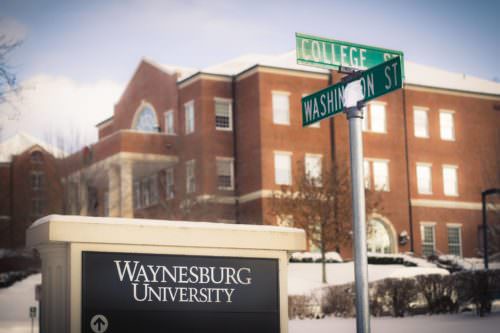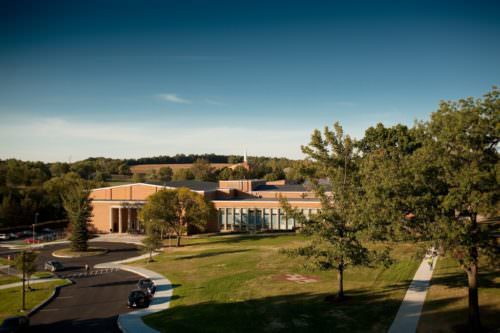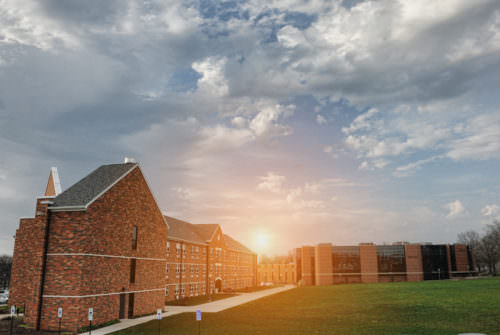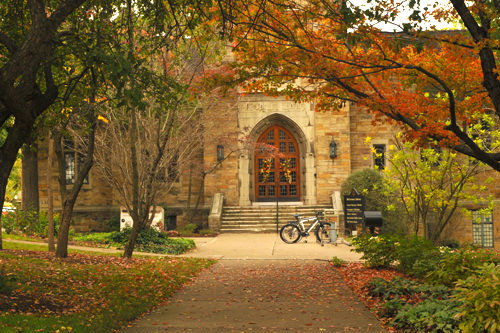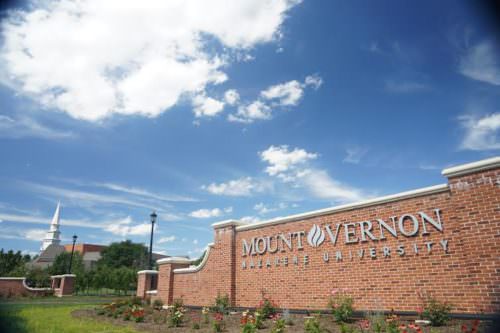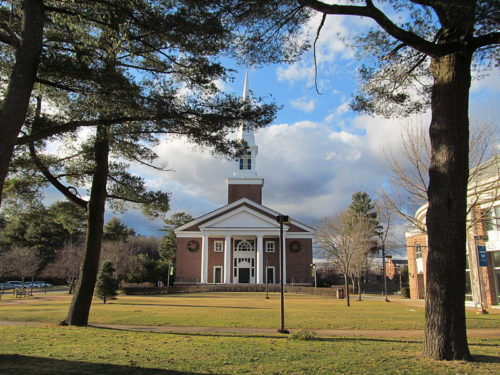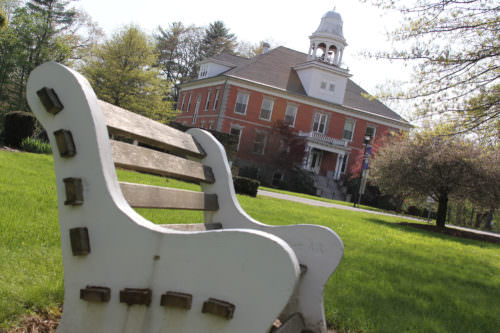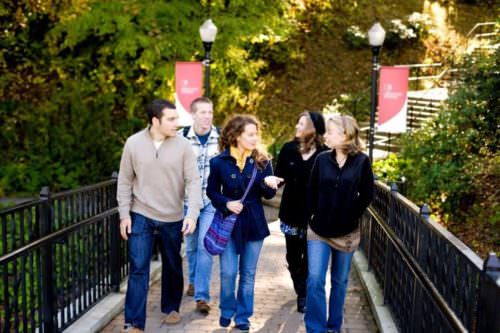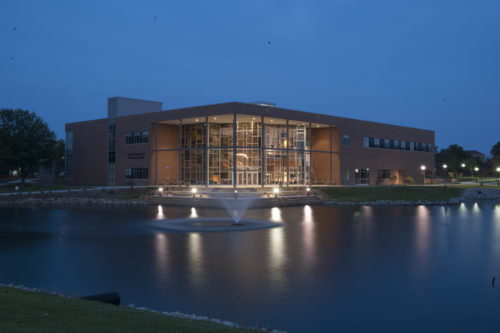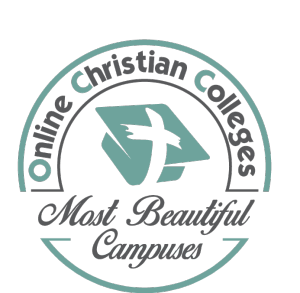
The environment of learning includes more than interior design of classrooms. Equally important is the campus setting, since the amenities, view, climate and campus layout play a part in the educational experience. A campus’ ability to harmonize with its surroundings while still maintaining a unique identity can be a strong influence in deciding where to obtain a degree.
While only one component of the decision, campus beauty should not be overlooked as an important factor. Online Christian Colleges is pleased to offer the Ten Most Beautiful Christian Colleges and Universities in the North 2018.
The methodology used for this ranking was, first of all, the schools had to be located in the northern reaches of the US (as far west as Ohio and as far south as Pennsylvania). Specific features reviewed include the continuity of the campus (including building integration with surroundings and overall layout), architectural style, the presence of any signature building or feature, and how well the campus fits with its surroundings. These features were graded and compiled into a preliminary list; this list was then reviewed and a final list was generated.
10 Eastern University
Saint Davids (Radnor Township), PA
Eastern University, located in Saint Davids (Radnor Township), PA, lies on the “Main Line” to the west of Philadelphia. This section of Pennsylvania dates back to 1681 when Richard Davies purchased 5000 acres of land from William Penn. The area relies on the Philadelphia economy, although there are several companies located in Radnor Township. Beginning in 1925 as a department in the Eastern Baptist Theological Seminary, in 1952 Eastern University became a separate institution and moved to its present location, taking the name Eastern Baptist College. In 1972, it was renamed Eastern College and achieved university status in 2001. According to the mission statement, “Eastern University is a Christian university dedicated to the preparation of undergraduate, theological and graduate students for thoughtful and productive lives of Christian faith, leadership and service. The mission is confirmed and celebrated when graduates believe their way into knowledgeable action that influences the world in substantive ways.”
Eastern University is accredited by the Middle States Commission on Higher Education; in addition, the school is accredited by seven other higher education organizations for specific programs. The University is comprised of seven schools: The College of Business and Leadership, The College of Education, The College of Arts and Sciences, The College of Health & Social Sciences, Esperanza College, Palmer Theological Seminary, and Templeton Honors College, and offers traditional undergraduate degrees in over 90 majors. The 114 acre campus was originally a private estate and showcases a wide variety of architectural styles. Each section of the campus has a unique look and feel; each section seems at home with the natural woodland beauty of the area, making it hard to believe it is so close to a major metropolitan area. The green spaces, tree-lined paths, and forest ponds add to the natural ambiance of the campus, providing a calm environment for the student.
9 Waynesburg University
Waynesburg, PA
Waynesburg University is located just 50 miles south of Pittsburgh, PA in the southwestern corner of the state, in coal country. This region is also home to an expansive natural gas reserve; it is energy that drives the local economy. The City of Waynesburg was established in 1796 and named for the Revolutionary War hero General “Mad” Anthony Wayne, one of General Washington’s top lieutenants. Waynesburg University was founded in 1849 by the Cumberland Presbyterian Church and began as “a strong vision and a pile of clay at the bottom of nearby Lake Juanita.” The Commonwealth of Pennsylvania chartered Waynesburg College in March 1850. According to the school’s mission statement, “Waynesburg University educates students to make connections between faith, learning and serving so they might faithfully transform their communities and the world. As a Christian comprehensive University, we strive to inspire and challenge every undergraduate and graduate student to a life of leadership and purpose for the glory of God.”
Waynesburg University is accredited by the Middle States Commission on Higher Education and is a member in good standing of three additional higher education organizations. The College offers over 70 degree programs including Biblical & Ministry Studies, Biology, Chemistry, Business, Education, Engineering, Mathematics & Computer Science, Nursing, Athletic Training & Exercise Science, History and Social Sciences. The 70 acre campus is adjacent to a large park area spanning entire city blocks and featuring tree-lined paths and a central fountain. Fountain Park is adjacent to Hannah Hall (home to the Business Department) and Miller Hall, which house the Administration Offices and are two of the oldest buildings on campus. The traditional red brick architecture blends well with the natural beauty of the forested mountains nearby. The rich history of the campus is present among the hand-made bricks of Miller Hall – still bearing the fingerprints of the craftsmen who built it.
8 Messiah College
Mechanicsburg, PA
Mechanicsburg is located just 8 miles from the Pennsylvania capital of Harrisburg. First settled in 1806 and incorporated in 1828, the town was named in recognition of the trade of many early settlers. Mechanicsburg played a part in American history during the War Between the States. The town is truly a crossroads as four interstate highways, 2 national roadways, a railroad, the Susquehanna River, and Appalachian Trail are all nearby. Messiah Bible School and Missionary Training Home was founded in 1909 by the Brethren in Christ Church; it moved to Mechanicsburg from Harrisburg in 1911. In the 1950s the school changed its name to Messiah College and expanded its academic offerings to over 60 undergraduate degrees. According to the school’s mission statement, “Our mission is to educate men and women toward maturity of intellect, character and Christian faith in preparation for lives of service, leadership and reconciliation in church and society.”
Messiah College is accredited by the Middle States Commission on Higher Education as well as three other program-specific accrediting bodies. The College also maintains memberships in seven educational organizations. Messiah College offers more than 150 majors in four schools: the School of the Arts; the School of Business, Education and Social Sciences; the School of Science, Engineering and Health; and the School of the Humanities. The 470 acre suburban campus features a variety of architectural styles, reflecting the rich heritage of the school. From the traditional design of academic buildings to the uniqueness of the covered bridge, the campus offers surprises at every turn. Perhaps the most interesting building is the Calvin and Janet High Center for Worship and Performing Arts. While not the geographical center of the campus, it is certainly the most eye-catching with its stunning use of mixed materials and glass resulting in a large multi-use facility that pleases all the senses.
7 Malone University
Canton, OH
Canton, OH lies 60 miles south of Cleveland and has a rich history of industry and football. Once a booming steel city, the local economy has transitioned to the service sector including finance, healthcare and education. Famous for the founding of professional football in America, Canton hosts the NFL Hall of Fame. In 1892, Walter and Emma Malone founded Cleveland Bible College as a small co-ed Bible school associated with the Society of Friends. Today, the school is affiliated with the Evangelical Friends Church-Eastern Region. The school moved to Canton in 1956 and became Malone College to honor its founders; it achieved university status in 2008. According to the school’s mission statement, “The mission of Malone University is to provide students with an education based on biblical faith in order to develop men and women in intellectual maturity, wisdom, and Christian faith who are committed to serving the church, community, and world.”
Malone University is accredited by The Higher Learning Commission (HLC) as well as five other undergraduate educational accrediting bodies. Malone University offers over 75 undergraduate degrees through its four schools: College of Theology, Arts, and Sciences, School of Nursing and Health Sciences, School of Business and Leadership and School of Education and Human Development. The campus is subdivided into separate sections. Most residence halls are clustered toward the center of the property; administration buildings and most academic buildings surround a small, tree-lined path-filled quad, and there are some large open areas for athletics and other activities close by. The residence hall quad provides an open area for leisure activities and dorm events. The traditional red brick architecture is prevalent throughout the campus, and the overall layout seems to act as a natural oasis amid its bustling suburban surroundings. Once on campus, it is hard to believe that this school is set in the middle of a small city.
6 Geneva College
Beaver Falls, PA
Less than 40 miles northwest of Pittsburgh and minutes from the Ohio border, Geneva College is located in Beaver Falls, PA. Founded in 1868 as Brighton, the town had the advantage of being along the highway, railroad and canal and was a common stopover for travelers. Once a bustling town, the decline in the steel industry has reduced the size of Beaver Falls to that of a small college town, although the CSX rail line is still active through the area. Founded in 1848 in Northwood, OH, Geneva College was named in honor of the city of Geneva, Switzerland for its central role in the Protestant Reformation. The school relocated to its current locale in 1880. Geneva is notable for its admission of freed southern slaves in 1865, which was uncommon at that time. According to the mission statement, Geneva College is a “Christ-centered academic community that provides a comprehensive education to equip students for faithful and fruitful service to God and neighbor.”
Geneva College is accredited by the Middle States Association of Colleges and Schools and maintains affiliation with 14 additional educational organizations. The college offers dozens of degree programs within several departments, including Aviation (for Missions and Business), Bible, Business, Biology, Education, Engineering and Computer Science, Music, and Social Sciences. The beautiful 55 acre campus sits among the hill country of western Pennsylvania, notable for its spectacular fall colors. Situated adjacent to the Beaver River, the campus features blended architectural styles representative of different historical periods; the campus layout around a central quad provides an inviting atmosphere that genuinely connects to the natural beauty surrounding the campus. Old Main, the oldest building on campus (dating to 1881), houses administrative offices as well as the John H. White Chapel. McCartney Library mimics the architectural style of Old Main and compliments the old building on the quad.
5 Mount Vernon Nazarene University
Mt. Vernon, OH
Mount Vernon Nazarene University is located in Mt. Vernon, OH, a sprawling suburban town 45 miles northeast of Columbus which was established in 1805. Named for George Washington’s plantation in Virginia, Mt. Vernon is home to a Siemens manufacturing plant (formerly owned by Cooper Industries). Founded in 1968 by the Church of the Nazarene, MVNU is one of eight liberal arts colleges affiliated with the Church of the Nazarene and is self-described as “a co-educational liberal arts university with an intentionally Christian foundation and mission.” That mission is summed up as “Mount Vernon Nazarene University exists to shape lives through educating the whole person and cultivating Christ-likeness for lifelong learning and service” and paired with the vision statement “To Change the World with the Love of Christ.” As the school approaches its 50th anniversary, it has made a significant impact in the realm of higher education, being referenced by several different independent ranking organizations.
Mount Vernon Nazarene University is accredited by the Higher Learning Commission and is a member of the Association of Independent Colleges and Universities of Ohio, the Council for Christian Colleges and Universities, the Council for Higher Education, and the Ohio Foundation of Independent Colleges. MVNU offers over 100 degrees from six schools: Arts and Humanities, Business, Education and Professional Studies, Theology and Philosophy, Nursing and Health Sciences, and Natural and Social Sciences. Anchored by the RR Hodges Chapel & Fine Arts Center at the main entrance; the campus features traditional red brick architecture in buildings surrounding the main quad. The quad features the Eternal Flame as well as the Shaw Bell Tower, erected in 1976 to honor the U.S. bicentennial, amid the open area and tree-lined paths. The campus abuts the Kokosing River and Delano Run, both offering natural beauty and ambiance in the middle of suburbia.
4 Gordon College
Wenham, MA
Less than 30 miles from Boston in Wenham, MA and only 3 miles from the coast, Gordon College sits among dense woodland insulated from the surrounding development, but not isolated from it. Wenham, which was established in 1643, boasts a rich pre-revolutionary history. Wenham and its neighbor Hamilton have been identified among the “best places to live” by Boston magazine. Historic buildings and local attractions are prevalent in this northeastern section of the state. Gordon College was founded in 1889 as Boston Missionary Training School and is named for its founder, the Rev. Dr. Adoniram Judson (A. J.) Gordon. In 1955, Gordon moved to its present location in Wenham. According to the mission statement, “Gordon College strives to graduate men and women distinguished by intellectual maturity and Christian character, committed to lives of service and prepared for leadership worldwide.” This goal is accomplished through the three elements of Commission: Stretch the Mind, Deepen the Faith and Elevate the Contribution.
Gordon College is accredited by the New England Association of Schools and Colleges (NEASC) and the National Association of Schools of Music (NASM) and offers degrees in over 35 majors, including Accounting, Art, Biblical Studies, Biology, Chemistry, Business, Economics, Education, History, Music, Political Science and Health. The 450 acre campus is comprised of a compact area of buildings and activity centers anchored by Frost Hall – called the “Castle” – and features a seamless blend of architectural styles. The academic quad features traditional red brick architecture that doesn’t distract from the natural surroundings of the woods. The athletic fields are close by and offer additional open area for a variety of activities. The AJ Gordon Memorial Chapel features the bell from the Clarendon Street Church where the founder was the pastor in the late 19th century. In addition to lush woodlands and rolling hills, the campus enjoys five great ponds; Coy Pond is closest to the central campus and offers a pleasant backdrop to the environment.
3 Houghton College
Houghton, NY
Amid the rolling hills and northern hardwood forests of Western New York State lies the campus of Houghton College. Situated in the Genesee River valley just 65 miles southeast of Buffalo, the school was founded in 1883 as a high school under the Wesleyan Methodist Connection. Houghton earned a provisional charter from New York State in 1923; its permanent charter was granted in 1927. According to the school’s mission statement, “Houghton College provides an academically challenging, Christ-centered education in the liberal arts and sciences to students from diverse traditions and economic backgrounds and equips them to lead and labor as scholar-servants in a changing world.” Houghton is one of three hamlets located within the town of Caneadea and it serves as a pleasant college town, although the college seems to occupy more area than the hamlet! The campus sits on the site of the former Caneadea Indian Reservation from the early 1800s.
Houghton College is accredited by the Middle States Association of Schools and Colleges and the Regents of the University of the State of New York and offers over 45 undergraduate degree programs as well as six online degree programs. The aesthetically pleasant campus is anchored by Fancher Hall, a historic and traditional red brick building with a wonderful bell tower; the campus is centered around a main quad headed by the John and Charles Wesley Chapel. The school’s consistent architectural design incorporates stonework, sandstone and glass throughout the campus; even the newest of buildings maintain these design features, providing a good flow over the entire campus. The campus also includes Houghton Forest, a woodland wonderland of nature trails and clearings to explore. Over and above the beautiful campus amenities are the Genesee’s magnificent Portage Falls and Letchworth State Park, voted the #1 State Park in the United States – just 15 miles away.
2 Grove City College
Grove City, PA
Grove City College, located in Grove City, PA, sits on 180 acres of rugged, rural land 60 miles north of Pittsburgh, 75 miles south of Erie and just 30 miles from the Ohio border. Grove City is home to GE Transportation, which manufactures locomotive engines and is a major source of the local economy. Founded in 1876 as Pine Grove Normal Academy, the school received its charter to become Grove City College in 1884. “The principles and values that the College was founded to advance – faithfulness, excellence, community, stewardship, and independence – are the same ones we hold fast to today.” According to the mission statement, “Grove City College equips students to pursue their unique callings through an academically excellent and Christ-centered learning and living experience distinguished by a commitment to affordability and its promotion of the Christian worldview, the foundations of free society, and the love of neighbor.”
Grove City College is accredited by the Middle States Commission on Higher Education and maintains formal affiliation with six other educational organizations. Degree programs include majors in Bible, Biology, Business, Chemistry, Communications, Computers, Economics, Education, Engineering, English, History, Mathematics, Music, Physics, Political Science and Psychology. The campus provides a pleasant environment, including traditional architecture blended with modern amenities. The varied styles do not interfere with one another – the feeling of the school’s rich history is honored in the old buildings while the more recent additions reflect relevance to today’s academic environment. The main quad is anchored by Harbison Chapel, standing for the steadfast Christian history of the school, and headed by Rockwell Hall of Science with its tower overlooking the western portion of the campus and serving as a reminder of the value of the academic study of God’s creation. The green spaces, Wolf Creek, and tree-lined paths allow students to stay in tune with nature and its cycles; the campus is inviting and provides an excellent backdrop to the pursuit of higher learning.
1 Cedarville University
Cedarville, OH
Cedarville University, situated on over 440 acres of semi-rural, fertile farmland is just 25 miles from Dayton, Ohio. Recognized for agriculture, aerospace and technology, this area of Ohio boasts a strong economy. Cedarville is small in overall size but enjoys a rich history dating back to 1837 (when it was founded as Milford, OH). The University was established in 1887 and originally affiliated with the Reformed Presbyterian Church; ownership of the College transferred in 1953, and Cedarville became a Baptist college. In 2002, after several expansions of programs and course offerings, the Board of Trustees unanimously voted to change from Cedarville College to Cedarville University. The University’s mission statement declares that “Cedarville University is a Christ-centered learning community equipping students for lifelong leadership and service through an education marked by excellence and grounded in biblical truth.” This is achieved by following the “portrait statements” affirmed by the school: Glorify God, Think Broadly and Deeply, Communicate Effectively, Develop Academically and Professionally, and Engage for Christ.
Cedarville University is accredited by the Higher Learning Commission and offers a variety of degree programs through its six schools: Biblical and Theological Studies, Business Administration, Education, Engineering and Computer Science, Nursing, and Pharmacy. Additionally, the school contains several departments: Art, Design, and Theatre; Communication; English, Literature, and Modern Languages; History and Government; Interdisciplinary Studies; Kinesiology and Allied Health; Music and Worship; Psychology; Science and Mathematics; and Social Work. All of this takes place in a lush rural setting in a temperate climate. The campus is centered around Cedar Lake and includes a pleasant blend of contemporary and traditional architectural styles. Founders Hall (built as ‘Old Main’ in 1895) greets campus visitors at the entrance with its stately red brick walls and tower. Newer buildings do not contradict the traditional feel of the school; rather they enhance the atmosphere of the traditional campus. Tree-lined walkways and several open areas lend to the open and airy feel of the campus, adding to the ambiance of the school.
Related Resources:
- 30 Most Beautiful Churches in France
- 30 Most Famous Mystics in History
- 50 Great Inspiring Christian Biographies
- 50 Most Beautiful Christian College Campuses
- 50 Most Beautiful Christian Colleges in the U.S.
